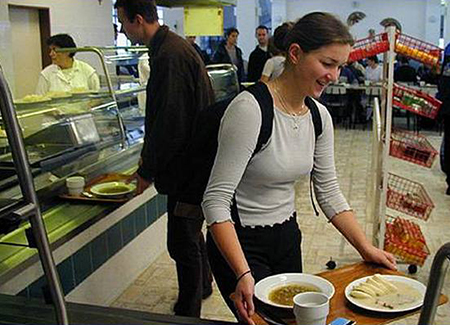
SMART Study Among First to Use Social and Mobile Tools for Weight Loss
Published Date
By:
- Tiffany Fox
Share This:
Article Content

At two years in duration, the SMART study is one of few weight loss interventions evaluated for longer than a year.
A newly published study by researchers at the University of California San Diego is among the first to test an intervention that used several technologies – including social media, apps, and text messaging – “to deliver state-of-the-science techniques to promote healthy changes in physical activity and diet,” said Assistant Professor of Family Medicine and Public Health Job Godino. Godino is affiliated with the Center for Wireless and Population Health Sciences (CWPHS), which is based at the UC San Diego Qualcomm Institute.
The study, known as SMART or “Social/Mobile Approach to Reduce Weight, was published in the July 14 edition of The Lancet Diabetes and Endocrinology.
Funded by the National Heart, Lung and Blood Institute, the SMART study evaluated a theory-based, weight loss intervention that was remotely delivered via integrated and personalized user experiences with Facebook, mobile apps (such as Trendsetter, GoalGetter and BeHealthy), text messaging, emails, a website, and technology-mediated communication with a health coach.
At two years in duration, it was also one of few weight loss interventions evaluated for longer than a year.
A total of 404 overweight or obese college students aged 18 to 35 years were enrolled and randomly assigned to either the SMART intervention or to receive general information about health and wellness via a website and quarterly emailed newsletters. After 24 months, the participants were assessed, and after adjusting for sex, ethnicity, and college of matriculation, the researchers found no significant difference in weight between the intervention and control groups.
“It's important to highlight that we did see modest weight loss after one year, but it wasn't maintained during the second year of the intervention,” explained Godino, who added that such results are typical of the few studies that do last more than one year.
“There are several potential reasons why the intervention might not have had as large of an impact as we had hoped for,” he continued. “We had some indication that engagement with the intervention components declined over time, so that could be one reason. We also know that some participants in the control group (the group not receiving the intervention) started using popular consumer devices and apps during the study. They were also friends on Facebook with participants in the intervention group. This might have resulted in the control group being far more similar to the intervention group than intended. This is an issue that in research we characterize as ‘contamination,’ and it's one that we are actively working to address.”
Notably, of those assigned to the intervention, 78 percent said they were satisfied and 80 percent said they would recommend it to others.
In an accompanying comment in The Lancet, Courtney Monroe and Gabrielle Turner-McGrievy of the Arnold School of Public Health and Technology Center to Promote Healthy Lifestyles (at the University of South Carolina, Columbia) noted that such studies are difficult given the “combination of the study design and the challenges related to fully understanding participants' level and nature of engagement with the technological modalities,” which make it difficult to determine which intervention components might have the greatest influence.
But they also acknowledged that the study fills "a literature gap" using an "innovative, ambitious, and timely approach."
Godino noted that many colleges and universities throughout the U.S. grapple with the challenge of helping overweight college students lose weight.
“We often put students who are transitioning from adolescence to young adulthood into highly stressful environments that include demanding schedules and access to a lot of unhealthy food,” he said. “It's the recipe for the weight gain that we see in most college students.”
Despite the study’s mixed results, Godino says his team was “able to promote (social support) in some really interesting ways using Facebook and participants’ social networks. Overall, we delivered the intervention in a personalized way that has a lot of potential to be scaled-up to large numbers of individuals.”
“It is important to understand that the results of this study do not mean that technologies generally can not be used to facilitate weight loss in college students,” he continued. “At the time that this study began, Facebook hadn't filed for an IPO, Fitbit hadn't released the Ultra (its second model), and most health-related smartphone apps were in their infancy. However, as the study went on, social media, wearables, and apps all improved greatly and became a much larger and more seamless part of our everyday lives. To provide an analogy, we asked participants to drive a 2011 Ford Focus towards weight loss, whereas today we can ask them to drive a Tesla Model S. The results are a piece of a much larger puzzle that I believe will eventually display the way that people can use technologies to optimize their weight loss.”
Given the rapid rate of social and technological change, Godino said the CWPHS team plans to shift its focus to “developing interventions that capitalize on popular consumer devices and apps instead of study designed tools.”
“We are working on integrating them with theory- and evidence-based content that they often lack, and in this way, we are striving to make our interventions a more accurate reflection of the advancing state of consumer wellness products. There is a lot left to learn.”
Share This:
You May Also Like
Stay in the Know
Keep up with all the latest from UC San Diego. Subscribe to the newsletter today.


